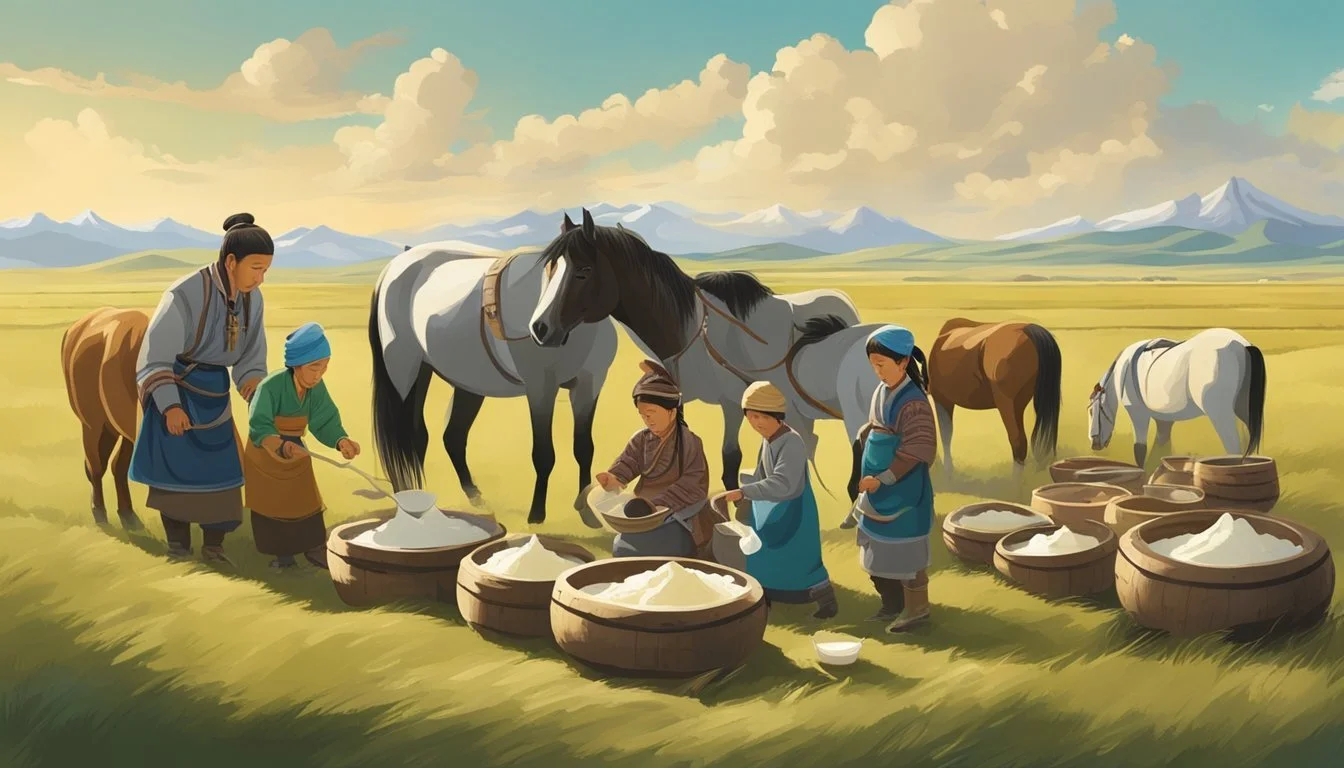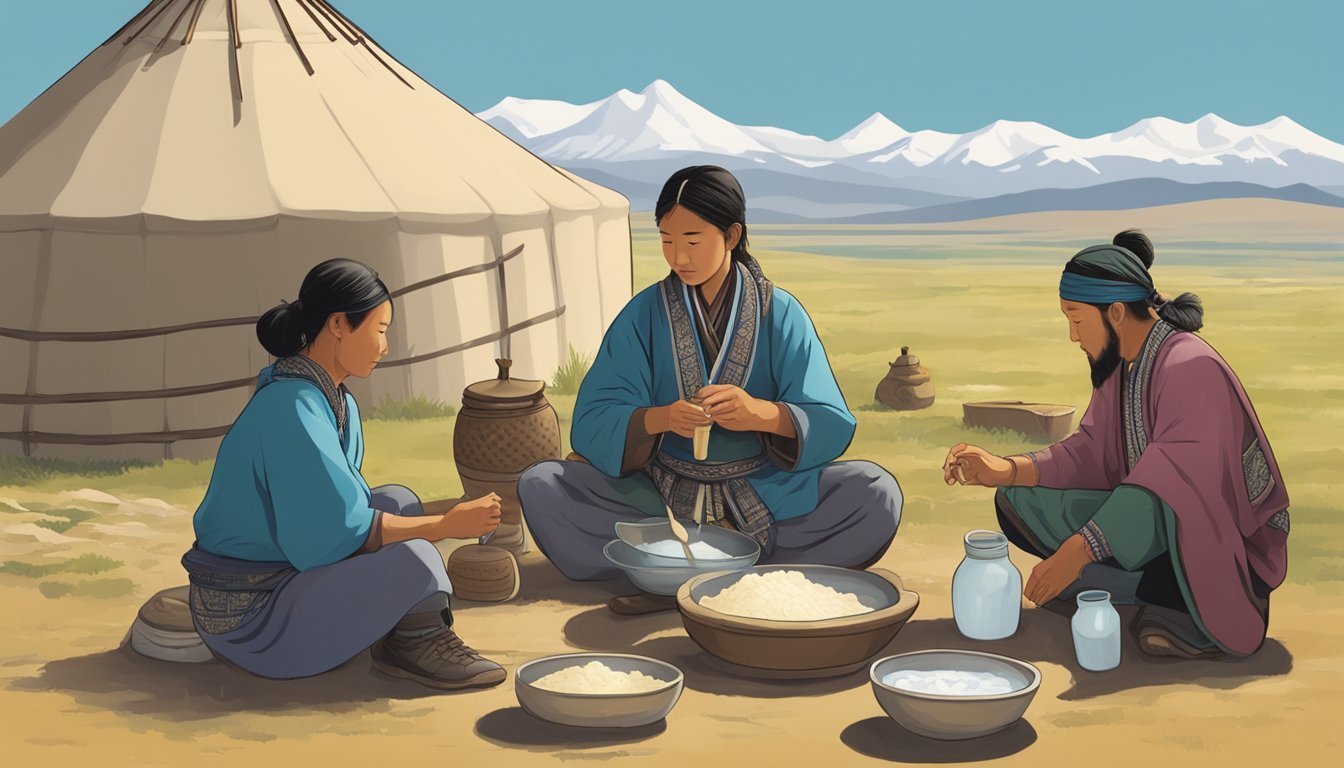Airag Unveiling the Secrets of Mongolia's Fermented Mare's Milk Tradition
Airag stands as a testament to Mongolia's rich pastoral culture, a traditional beverage deeply rooted in the nomadic lifestyle of the Central Asian steppes. It is a fermented horse milk known for its distinctive taste and slightly alcoholic content. The making of airag is a time-honored process that involves the milking of mares, a practice that can only be carried out during the summer months from July until late September. Upon milking, the fresh milk is fermented, a crucial transformation that bestows upon airag its unique character and benefits. This fermentation process can vary from a few hours to several days, depending on various conditions and desired outcomes.
In Mongolia, airag is more than just a drink; it holds a significant place as the national beverage and symbolizes hospitality and tradition. It is commonly consumed during Mongolian festivals and is a staple in the daily lives of many nomadic families. The beverage is not only enjoyed for its taste but also for its nutritional value, containing protein, fats, vitamins A, C, E, and D. Its introduction to visitors is considered a gesture of welcome and respect, making airag an integral part of the social fabric.
The cultural significance of airag goes beyond its consumption. The beverage is intertwined with the importance of the horse in Mongolian society, where horses are revered and play a central role beyond transportation and labor. They are a source of sustenance, and their milk, once fermented into airag, is shared among families and friends, strengthening community bonds. This cherished drink encompasses the essence of Mongolia’s nomadic heritage and continues to be a symbol of the country's identity.
Origins and History
Airag, the traditional Mongolian fermented horse milk, carries a profound historical significance and has undergone an evolution in its fermentation techniques over the centuries. This unique beverage is deeply rooted in the nomadic traditions of Central Asia.
Historical Significance of Airag
Airag has been a staple in the Mongolian diet for centuries, with its origins tied closely to the nomadic herders of the region. The Mongols, known for their exceptional equestrian skills, revered horses not only for transportation and labor but also for the nutritional value of mare's milk. Fermentation was a practical method to preserve the milk during long journeys and the harsh climatic conditions of the Mongolian steppes. The historical impact of airag is such that it is more than a drink; it is a symbol of Mongolian hospitality and culture.
Evolution of Fermentation Techniques
Originally, the fermentation process was a natural occurrence, initiated by lactic acid bacteria and yeasts present in the environment and the mare's milk itself. Over time, Mongolians developed and refined this technique. They discovered that regular stirring and agitating the milk in traditional containers like leather sacks or wooden barrels would enhance the fermentation. This method also helped in controlling the taste and alcohol content of the airag. This cultural tradition has been passed down through generations, with each family often having their own methods and secrets to produce the best quality airag.
Production
The production of Airag involves a meticulous fermentation process that commences with the milking of mares. It incorporates time-honored techniques and, in some instances, modern adaptations to uphold its cultural significance and cater to contemporary practices.
Traditional Methods
In the traditional method of producing Airag, nomadic herders in Mongolia first obtain mare's milk during peak lactation times, typically between June and September, when mares are milked frequently throughout the day. Fermentation begins by pouring the fresh milk into a ger, a large leather bag or wooden container often found in the traditional Mongolian tents. A crucial part of this process is the constant stirring of the milk, traditionally done with a khukhuur, a long wooden masher, which helps to evenly distribute the naturally occurring microbes and yeasts.
To initiate fermentation, dried yeast or a small amount of previously fermented Airag is introduced to the fresh mare's milk. The milk is then left to ferment for several hours to a few days, depending on ambient temperatures and desired sourness levels. During this period, the lactose in the milk is converted into lactic acid, alcohol, and carbon dioxide, giving Airag its distinct fizzy texture and tangy taste.
Modern Adaptations
The modern production of Airag occasionally veers from the conventional realm, incorporating certain technological advancements while retaining the core recipe. To scale up the process for larger production, stainless steel containers might replace the traditional ger, and controlled environments may be used to ensure consistent quality.
Despite these modern practices, the essence of Airag production remains rooted in the original steps. Fermentation still requires careful monitoring, and while mechanical stirrers can take the place of the khukhuur, some producers adhere to the manual method to preserve authenticity. Today, alongside traditional setups, select commercial entities produce Airag, making this fermented beverage more accessible beyond the nomadic herdsman's reach while striving to maintain its unique flavor profile and cultural heritage.
Cultural Practices
The culture surrounding Airag in Mongolia is deeply rooted in tradition, involving specific rituals and being integral to daily life, reflecting hospitality and custom.
Rituals and Celebrations
In Mongolia, Airag plays a central role in Naadam, the most widely celebrated festival, often referred to as the “three games of men,” which include horse racing, wrestling, and archery. During this event, Airag is consumed in abundant quantities, symbolizing respect and good fortune. The drink is also featured prominently during Tsagaan Sar (the Mongolian Lunar New Year), where it is served to guests as a sign of hospitality. Offering Airag to visitors is more than just courtesy; it's a centuries-old custom that honors the guest and celebrates the significance of the horse in Mongolian culture.
Daily Consumption
On a day-to-day basis, Airag is more than just a beverage; it's a staple of the diet for nomadic herders. This fermented mare’s milk is enjoyed at meals and is often the drink of choice due to its nutritional properties and availability. Daily consumption is common, and it is not reserved for special occasions or feasts. In many herder’s families, the tradition of making and drinking Airag is passed down from generation to generation, emphasizing its role in the daily fabric of Mongolian life.
Health and Nutrition
Airag, Mongolia's traditional fermented mare's milk, is not only a culturally significant beverage but also an interesting addition to the nutritional landscape. It contains a unique composition of nutrients and has potential health benefits associated with its consumption.
Nutritional Content
Concerning nutrition, Airag's nutritional profile is a distinct blend, largely constituted by vitamins, minerals, and protein. A typical serving size of Airag might contain the following:
Proteins: Essential for muscle repair and enzyme functions.
Vitamins: Particularly Vitamin C, which is vital for the immune system.
Minerals: Includes a variety of minerals necessary for body functions.
While specific nutritional values can vary, one can expect Airag to enrich the diet with these essential nutrients.
Potential Health Benefits
Consumers may gain several health benefits from Airag, primarily due to its fermentation by lactic acid bacteria and probiotics. These components are believed to contribute to:
Digestive Health: Probiotics can aid in maintaining a healthy balance of gut flora.
Immune System: The presence of Vitamin C and probiotics support immune function.
Regular consumption of Airag could potentially have a positive impact on heart health due to the fermentation process, which is thought to produce bioactive components. However, the extent of these effects can vary among individuals and should not be overstated. It is important to consider the full nutritional context of one's diet when assessing the role of Airag in health and nutrition.
Consumption Experience
Sipping on Airag offers a unique experience that varies from other beverages due to its distinct taste and the traditional serving methods. One's palate is greeted with a combination of flavors and textures that are intrinsic to this Mongolian specialty.
Taste Profile
The flavor of Airag is primarily sour, with a natural fermentation tang similar to other dairy ferments, but it also carries a subtle sweetness. Given that it is a product of fermented mare's milk, the taste can be somewhat acrid for those unaccustomed to fermented milk beverages. Airag's alcohol content is low, typically ranging between 0.5% to 2.0%, which imbues it with a slight alcoholic note without being overpowering.
Texture and Serving
Airag presents a creamy texture that is smoother than most dairy drinks, a result of the fermentation process. Traditionally, it is served chilled in a large bowl, which allows one to appreciate its body and consistency. The cool temperature enhances the refreshing qualities of the beverage, making it a desirable drink, especially during the summer months.
Regional Variations
In Mongolia, the traditional beverage Airag is not just a drink, it's a symbol of nomadic heritage with regional variations in its production. These differences give rise to a rich tapestry of tastes and preparation methods that are distinct to various parts of the country.
Differences Across Mongolia
In Western Mongolia, the Airag-making process is influenced by the harsher climate and the distinct breeds of horses that are adapted to that region. The method of fermenting horse milk can vary slightly depending on the area, with some regions incorporating specific types of lactic acid bacteria that thrive in their particular environmental conditions. In the capital, Ulaanbaatar, the access to equipment and modern technologies might slightly alter the fermentation process, giving the Airag produced there a more consistent quality and taste when compared to that of remote nomadic groups.
Comparison with Kumis
While Airag is the beverage of choice in Mongolia, in Kazakhstan and other parts of Central Asia, a similar fermented milk drink known as Kumis is prevalent. Kumis, although related to Airag, often has a milder taste due to the different fermentation methods and the specific strains of yeast and bacteria used. These variations may also be due to the type of mare's milk used, as the forage consumed by the horses can influence the flavor profile of both Airag and Kumis, reflecting the distinct ecosystems of Mongolia and Kazakhstan.
Ecological and Agricultural Aspects
In the expansive grasslands of Mongolia, the production of Airag intertwines with the ecological fabric and agricultural practices unique to this region.
Role of Horses in Mongolian Life
Horses hold a central place in the lives of Mongolian nomads. These animals are not only revered as essential companions to the nomadic people but are also pivotal to the agricultural economy. The horses roam the countryside, grazing on the rich grass that characterizes the Mongolian steppes. It is from these horses that nomads obtain the raw ingredient for Airag—mare's milk. This milking, predominately done during the spring and summer months, aligns with traditional practices that respect the natural cycle of equine lactation.
Spring: Beginning of the milking season as mares give birth and pastures burgeon.
Summer: Peak production as continuous sunlight and warm temperatures boost milk yields.
Environmental Factors Influencing Production
The production of Airag is acutely influenced by environmental factors. The quality and accessibility of grass are heavily dependent on sun exposure and precipitation patterns. Changes in climate, including harsh winters or dry spells, can substantially alter the pasturelands and, consequently, the mare's milk output.
Sunlight: Essential for grass growth, impacting the milk's nutritional value.
Spring/Summer Transition: Crucial period when production ramps up due to optimal conditions.
During the transition from summer to autumn, the continued availability of fresh grass dictates the end of the milking period. As the nomads follow their herds in search of better pastures, the health of the grassland ecosystems remains a key concern, revealing the deep connection between the environment and the age-old tradition of Airag production.
Modern Day Significance
Airag retains a significant place in Mongolia's cultural and social landscape while also capturing international interest as an exotic and traditional beverage.
Airag in Contemporary Mongolia
In today's Mongolia, Airag remains highly esteemed both as a national beverage and a symbol of hospitality. It holds cultural significance at various national and local festivals, where sharing Airag is a way of preserving a deep-rooted heritage. This fermented mare's milk, often likened to the Central Asian Kumis, is more than a drink; it represents the continuing legacy of the Mongolian nomadic lifestyle. In urban areas, while the consumption might be less frequent, it's often consumed during Naadam Festival and Tsagaan Sar, Mongolian Lunar New Year, thereby reaffirming its status in the national identity.
Global Outreach and Perception
Globally, the perception of Airag is that of a unique culinary experience. As travelers seek authentic experiences, many become intrigued by traditional practices such as the fermentation of horse milk. Airag or its variant Kumis has stepped outside Mongolian borders, finding a place in global food festivals and niche food markets that celebrate traditional and distinctive flavors from around the world. However, its taste and production process can be quite unexpected to the uninitiated palate, leading to a wide range of reactions from curiosity to appreciation.









